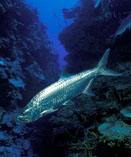| Family: |
Megalopidae (Tarpons) |
| Max. size: |
250 cm TL (male/unsexed); max.weight: 161 kg; max. reported age: 55 years |
| Environment: |
reef-associated; freshwater; brackish; marine; depth range 0 - 40 m, amphidromous |
| Distribution: |
Atlantic Ocean: from Nova Scotia, Bermuda and southward to Brazil in western Atlantic Ocean (Ref. 3234, 4446), where it it also found throughout the Gulf of Mexico and the Caribbean (Ref. 26938); from Mauritania to Angola in eastern Atlantic Ocean (Ref. 2845, 3234, 4446, 81266); with exceptional records in Portugal, Azores and Atlantic coast of southern France (Ref. 3234, 4446). Crossed the Panama canal and was caught at Coiba Island in the Pacific Ocean (Ref. 4446). |
| Diagnosis: |
Dorsal spines (total): 0-0; Dorsal soft rays (total): 13-16; Anal spines: 0-0; Anal soft rays: 22-25; Vertebrae: 53-57. Diagnosis: It is characterized by the anterior position of pelvic fin insertions in relation to dorsal-fin origin, and by some morphometric counts: 13-16 dorsal-fin rays, 40-48 lateral-line scales and 53-57 vertebrae (Ref. 2845, 81266).
Description: Body moderately deep, rather strongly compressed (Ref. 3234, 4639). Head moderately short and deep with dorsal outline nearly straight and horizontal; snout considerably shorter than eye in small specimens, becoming equal and longer than eye during growth; eye 3,3-4,7 times in head (Ref. 3234). Mouth oblique, lower jaw prominent, with a gular plate visible ventrally between its two branches (Ref. 2845, 81266). Gillrakers rather long and slender, scarcely denticulate (Ref. 3234). Fins spineless; dorsal fin short-based, inserted at midlength of body, its last ray filamentous; anal-fin base much longer, its origin placed rearwards in relation to dorsal fin end; pectoral fins set very low on body; pelvic fins inserted in advance of dorsal-fin origin; caudal fin deeply forked (Ref. 2845, 3234, 26938, 81266). Scales large, cycloid, those in lateral line numbering 40-48 and ornamented with branched tubes (Ref. 2845, 81266).
Colouration: Back bluish-grey, sides brilliant silvery (Ref. 2845, 3234, 81266). |
| Biology: |
Inhabit coastal waters, bays, estuaries, mangrove-lined lagoons, and rivers (Ref. 3789, 27188). Often found in river mouths and bays, entering fresh water (Ref. 27227). Lower depth limit at 40m (Ref. 118621). Large schools may frequent particular spots for years (Ref. 9710). Feed on fishes like sardines, anchovies, Mugilidae, Centropomus, Cichlidae (mainly those forming schools) and crabs (Ref. 3789, 27188). The swim bladder, attached to the esophagus, can be filled directly with air and permits the fish to live in oxygen-poor waters. Has high fecundity, a 203 cm female is estimated to produce over 12 million eggs (Ref. 10863). Spawn in waters which can be temporarily isolated from the open sea (Ref. 27188). Transparent leptocephalus larvae migrate into estuaries (Ref. 57533). Famous for its spectacular leaps when hooked. Marketed fresh or salted (Ref. 3789). Large scales are used in ornamental work and in preparation of artificial pearls (Ref. 3789). Used to be cultured commercially in Colombia (Ref. 7306). Highly appreciated by sport fishers. The flesh is also highly appreciated despite its being bony (Ref. 27188). The world record for hook and line is 283 lbs. from Lake Maricaibo, Venezuela (Ref. 13442). |
| IUCN Red List Status: |
Vulnerable (VU); Date assessed: 12 June 2018 (A2bd) Ref. (130435)
|
| Threat to humans: |
reports of ciguatera poisoning |
Source and more info: www.fishbase.org. For personal, classroom, and other internal use only. Not for publication.
